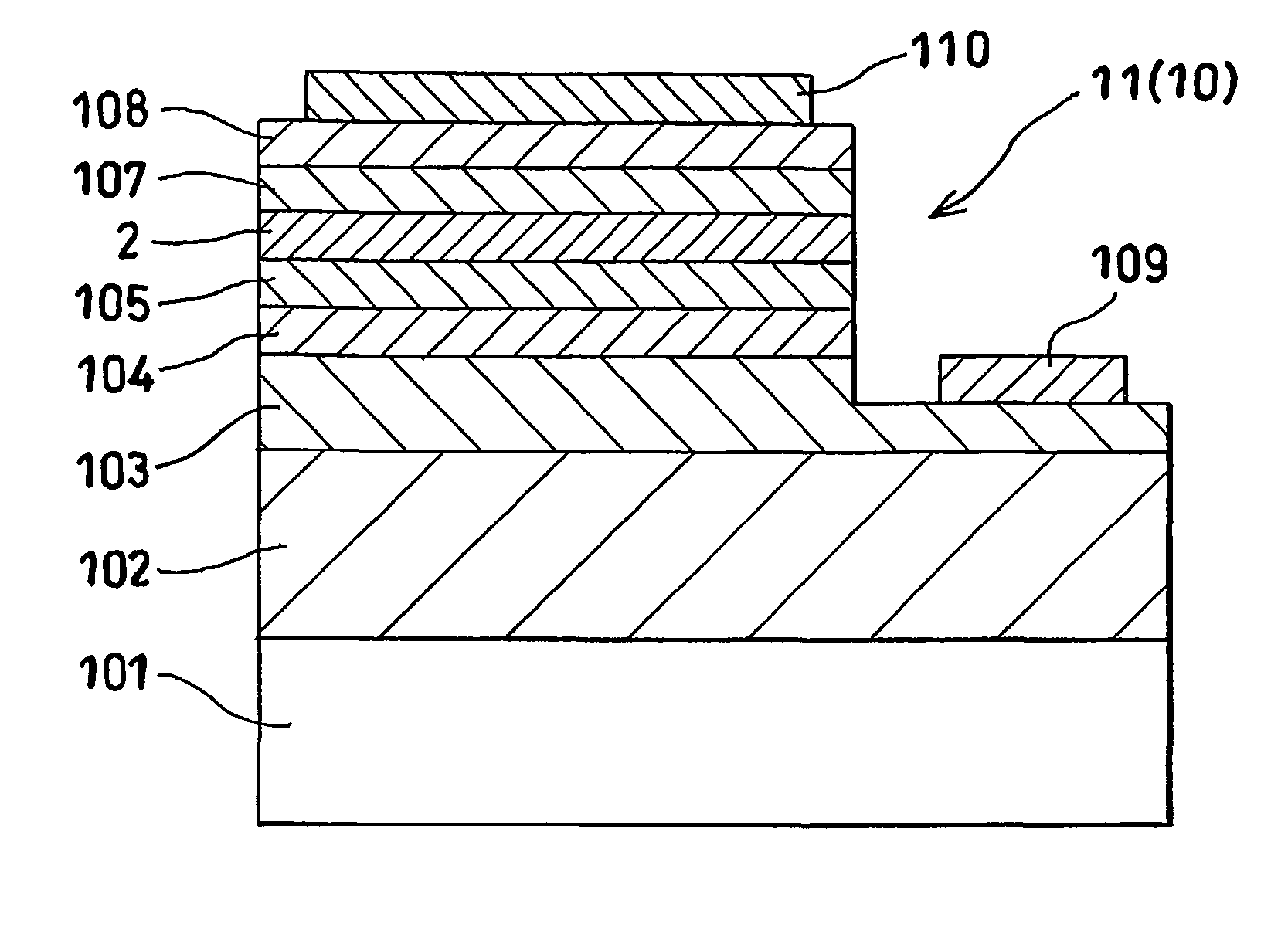Pn junction type group III nitride semiconductor light-emitting device
a technology of nitride and semiconductors, applied in semiconductor lasers, lasers, solid-state devices, etc., can solve the problem of reducing the output of light-emitting devices by the same amount, and achieve the effect of improving the crystallinity of the well layer and improving the light-emitting efficiency
- Summary
- Abstract
- Description
- Claims
- Application Information
AI Technical Summary
Benefits of technology
Problems solved by technology
Method used
Image
Examples
example 1
[0053]The present invention will be described concretely based on a case in which a Group III nitride semiconductor light emitting diode is produced using a light-emitting layer of multiple quantum well structure of the present invention formed on a sapphire substrate.
[0054]FIG. 1 is a schematic sectional view of a stacked structure used for producing the LED of Example 1. FIG. 2 is a schematic diagram showing a structure of the light-emitting layer of the stacked structure shown in FIG. 1. FIG. 3 is a schematic plan view of the LED produced from the stacked structure shown in FIG. 1.
[0055]To form a stacked structure 11 for producing an LED 10, a sapphire substrate 101 was placed in a quartz MOCVD reaction furnace around which an induction heating radio frequency (RF) coil was disposed. Nitrogen gas was allowed to flow therein for 10 minutes to purge the inside of the reaction furnace and then, the temperature of the substrate 101 was increased from the room temperature to 1150° C. ...
example 2
[0073]In Example 2, the contents of the present invention will be explained concretely based on a case in which a Group III nitride LED is formed using the light-emitting layer of multiple quantum well structure having barrier layers. The thicknesses of the barrier layers are different from one another.
[0074]In Example 2, in forming the multiple quantum well structure constituting the light-emitting layer described in Example 1, the thickness of the barrier layer of the one end layer (21m in FIG. 2) was set to 15 nm, that of the second barrier layer was set to 16 nm, that of the third barrier layer was set to 17 nm, thickness of the fourth barrier layer was set to 18 nm, and that of the fifth barrier layer was set to 19 nm.
[0075]That is, the multiple quantum well structure was formed, with the thicknesses of the Si dope GaN barrier layers reduced from the n-type clad layer (105 in FIGS. 1 and 2) toward the p-type clad layer (107 in FIGS. 1 and 2). The thickness of the Si dope GaN ba...
example 3
[0077]The present invention will be described concretely based on a case in which a Group III nitride semiconductor layer is formed using a light-emitting layer of multiple quantum well structure utilizing as the other end layer a barrier layer in which impurities were distributed.
[0078]In Example 3, the other end layer 21n forming the multiple quantum well structure described in Example 1 was made of an Si-doped GaN layer in which the concentration of Si impurities was set to be low on the side of the junction region with respect to the well layer, was higher at the central portion of the layer, and was gradually reduced from the central portion in the thickness-increasing direction (toward the p-type clad layer 107).
[0079]In the other end layer, the concentration of Si impurities from the junction region with respect to the well layer to an internal region of 5 nm in the thickness-increasing direction was set to 3×1017 cm−3. The concentration of Si impurities in a central region o...
PUM
 Login to View More
Login to View More Abstract
Description
Claims
Application Information
 Login to View More
Login to View More - R&D
- Intellectual Property
- Life Sciences
- Materials
- Tech Scout
- Unparalleled Data Quality
- Higher Quality Content
- 60% Fewer Hallucinations
Browse by: Latest US Patents, China's latest patents, Technical Efficacy Thesaurus, Application Domain, Technology Topic, Popular Technical Reports.
© 2025 PatSnap. All rights reserved.Legal|Privacy policy|Modern Slavery Act Transparency Statement|Sitemap|About US| Contact US: help@patsnap.com



